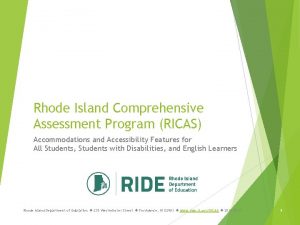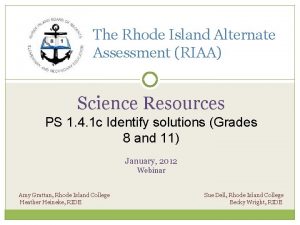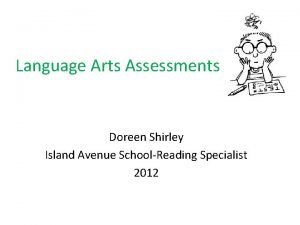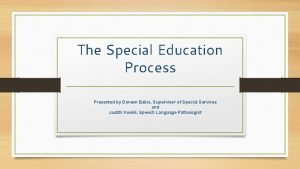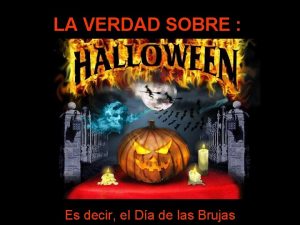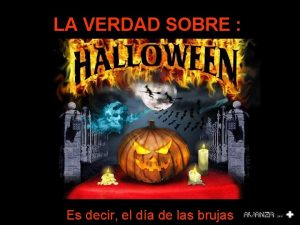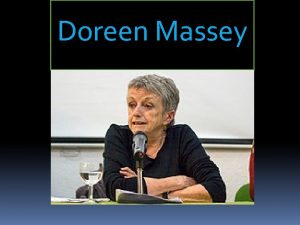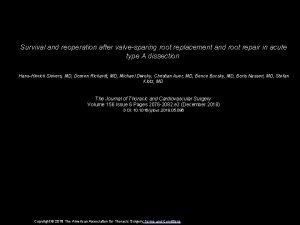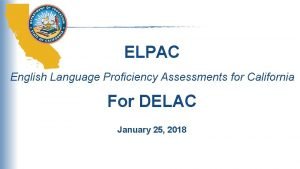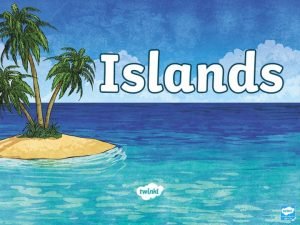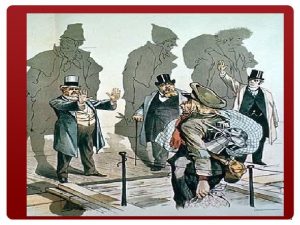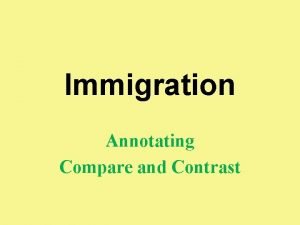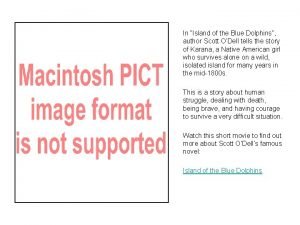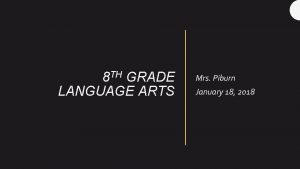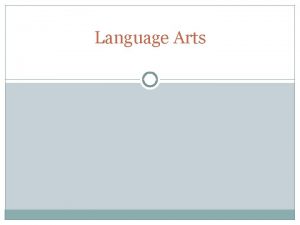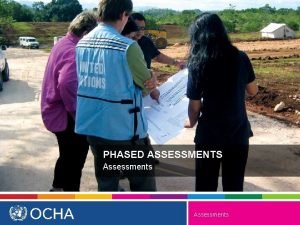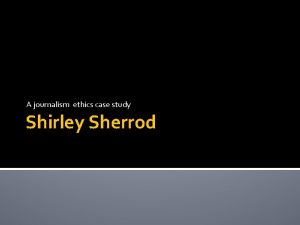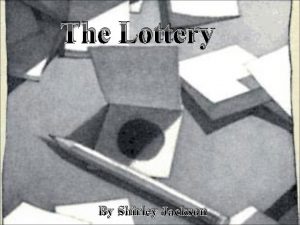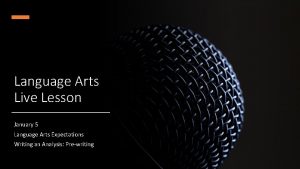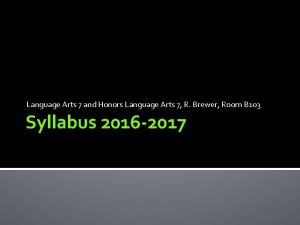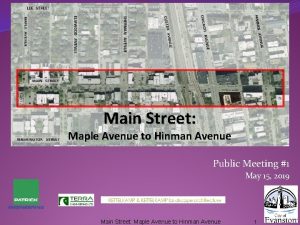Language Arts Assessments Doreen Shirley Island Avenue SchoolReading




















- Slides: 20

Language Arts Assessments Doreen Shirley Island Avenue School‐Reading Specialist 2012

Why? • Assessment is information. The more information we have about students, the clearer the picture we have about achievement or where gaps may occur. • The more we know about individual students as they engage in the learning process, the better we can adjust instruction to ensure that all students continue to achieve by moving forward in their learning.

Summative Assessment • Summative Assessments are given periodically to determine at a particular point in time what students know and do not know. Some examples of summative assessments are: v CMT v DRA v DRP v DIBELS v Writing Prompt • Think of summative assessment as a means to gauge, at a particular point in time, student learning relative to content standards. Although the information that is gleaned from this type of assessment is important, it can only help in evaluating certain aspects of the learning process.

Formative Assessment • Formative Assessment is part of the daily instructional process. When incorporated into classroom practice, it provides the information needed to adjust teaching and learning while they are happening. These adjustments help to ensure students achieve targeted, standards‐based learning goals within a set time frame. • Some of the instructional strategies that can be used formatively include the following: v Observations that assist teachers in gathering evidence of student learning to inform instructional planning. v Questioning strategies which allows opportunities for deeper thinking and provides teachers with significant insight into the degree and depth of understanding. v Self assessment by students who can reflect while engaged in metacognitive thinking are involved in their learning.

Balanced Approach • In order to better understand student learning, teachers need to consider information about the: vproducts (paper or otherwise) students create vtests they take v teacher’s observational notes vreflections on the communication that occurs. • When a comprehensive assessment program at the classroom level balances formative and summative assessments, a clear picture emerges of where a student is relative to learning targets and standards.

DIBELS © & DIBELS NEXT © Dynamic Indicators of Basic Early Literacy • • • Given 3 times a year in Grades K, 1 & 2. DIBELS is made up of short individual tests, called subtests. Each subtest focuses on a different skill. During an assessment session, the student may be given one to three of the subtests depending on his or her grade level. Each subtest takes only about one minute to perform. The subtests are: v Letter Naming Fluency (LNF): Assesses a child's skill at identifying both upper and lower case letters of the alphabet. v First Sound Fluency (FSF): Assesses a child's skill at identifying and producing the initial sound of a given word. v Phonemic Segmentation Fluency (PSF): Assesses a child's skill at producing the individual sounds within a given word. v Nonsense Word Fluency (NWF): Assesses a child's knowledge of letter‐sound correspondences as well their ability to blend letters together to form unfamiliar words. v Oral Reading Fluency (ORF): Assesses accuracy and fluency when reading printed text, the ability to effortlessly translate letters‐to‐sounds‐to‐words. Retell is a comprehension subset of ORF. Retell assesses the student's ability to recall important literary elements (main characters, setting, plots, problem/solution) along with sequencing of key events in the story. Scores indicate: At Risk , Some Risk, Low Risk

Developmental Reading Assessment (DRA‐ 2) • • Research‐based assessment used to determine a student’s independent reading level. The DRA helps teachers pinpoint students’ strengths and reading abilities in a one‐on‐one conference. Given 3 times a year to all students in grades K‐ 4 Provides independent reading level between A and 50. What DRA measures: v Dispositions toward Reading‐student’s attitude about reading and his or her reading habits. v Reading Interests-the kinds of texts a student likes to read. v Oral Reading Accuracy-how correctly a student reads aloud the words in the text. v Fluency and Intonation‐how smoothly and expressively a student reads the text. v Comprehension‐at early levels students retell the story in their own words. At higher levels, students summarize the text in their own words.

DRA‐ 2 Benchmarks Grade Level Fall Winter End of School Year First 8 12 18 Second 20 24 28 Third 30 34 38 Fourth 40 50

Degrees of Reading Power ® (DRP) • The DRP Tests are group‐administered assessments requiring students to read a variety of nonfiction paragraphs arranged from easy to difficult. • Third and fourth‐grade students read six non‐fiction passages. Each passage contains deleted words requiring students to replace each omitted word with one of five possible choices. • The aspect of comprehension being assessed is referred to as the surface meaning of text. • Test performance on the DRP is converted to the same DRP units used to index the difficulty of books. For example, a DRP test score of 41 would indicate that a student would be expected to read and comprehend Frog and Toad are Friends, which also corresponds to a DRP readability Index of 41. A DRP test score of 50 would correspond to the book Charlotte’s Web, while a DRP score of 61 corresponds to Jane Eyre.

DRP Benchmark Scores Grade Fall Score Third 40 (+ 3) Fourth 50 (+ 3)

DRP Sample

Writing Prompts • A writing prompt is a statement about a particular topic, which is used to challenge the students’ thinking power and arouse their creative writing talent. • The clear explanation of the sequence of events, elaboration of the main event, inclusion of thoughts and feelings, some suspense and a satisfying ending makes a good narrative writing prompt. • Given three times a year in Grades 2, 3 and 4. Given in the spring only of Grade 1 and not scored. • Blind scored by 2 teachers and adjudicated if necessary. • Scores of NS‐ 6 • Expository prompt in spring of Grade 4

Writing Prompt Benchmark Scores Grade Level Fall Winter Spring Second 4 6 6 Third 7 8 8 Fourth 8 8 Expository Check‐list

Developmental Spelling Assessment (DSA) • • Grades 1‐ 4 This is an assessment of student’s knowledge of word features. Instruction begins at the student’s ability level, which falls into one of these five spelling stages v Letter Name Stage: This stage is based on children’s knowledge of the alphabet and beginning attempts to read, is characterized by an attempt to match alphabetic letter names to salient phonemes, or speech sounds, within the words being spelled. v Within‐Word Pattern: This stage is characterized by greater experience with print and leads to an increased awareness of how words work, and in turn to more conventional spelling. v Syllable Juncture: The focus at this stage is on preserving the pattern principles across syllable boundaries. v Derivational Constancy: The words are of relatively low frequency and primarily of Greek and Latin origin. • Once students have been placed in their appropriate stage, instruction begins for the students at what is termed “using but confusing” –those spelling features they are beginning to use but confuse.

Fry Word Lists • High frequency words are words that are used most often in text to be read. • For students to read fluently, they need to be able to read “high frequency” words automatically, without sounding them out. • Grades K, 1 & 2

The Fry list of 600 words are the most frequently used words for reading and writing. The words are listed in rank order. An example of some Fry words: of and a to in is you that it he was for on are as with his they I at be this have from or one had by word but not what all were we when your can said there use an each which she do how their if will up other about many then them these so some her would make like him into time has look two more write go see number no way could people my than first water been call who oil now find long down day did get come made may part over

Fry Word Expectations Grade # of Words by Year’s End Kindergarten 1‐ 40 First 1‐ 200 Second 1‐ 300

Connecticut Mastery Test (CMT) • Reading score is a combination of 2 scores: Degrees of Reading Power® and Reading Comprehension. Each test accounts for 50 % of the total reading score. Results for the total reading test are reported relative to state standards. • DRP test is administered in one 45 minute session. • The Comprehension test assesses a student’s ability to read and understand both fiction and nonfiction passages. The Reading Comprehension test is administered in two 45‐ minute sessions in Grades 3 through 8. The test includes a combination of multiple‐choice and short‐answer questions. • Multiple‐choice questions require students to identify the correct answer from four options and short‐answer questions require students to provide a written response.

CMT Reading Strands Forming a General Understanding – Students who master this content strand demonstrate a basic understanding of the general content of written work typically found in grade‐level text. Generally, these students can determine the main idea or theme and identify important characters, settings, events and details. They can effectively select and use relevant information to summarize a written work. Developing Interpretation – Students who master this content strand can effectively interpret and explain what they have read. Generally, these students can draw conclusions about an author’s purpose and use information from the text to draw and support their conclusions. They can also identify an author’s use of text organizational patterns. Making Reader/Text Connections – Students who master this content strand can connect or associate the ideas in a written work to their own lives. Generally, these students can make connections between a text and outside experiences and knowledge, and can select and use relevant information from the text to write a personal response to the written work. Examining the Content and Structure – Students who master this content strand can respond critically to what they have read and make judgments about the text’s quality and themes. Generally, these students can analyze and evaluate the author’s craft and use of literary devices. These students are able to select and use relevant information from the text to extend or evaluate the written work.

Questions
 Creative arts grade 6 term 3 assessment
Creative arts grade 6 term 3 assessment Ricas math
Ricas math Rhode island comprehensive assessments system
Rhode island comprehensive assessments system Shirley island
Shirley island Who did richard ramirez marry
Who did richard ramirez marry Ricardo leyva ramirez
Ricardo leyva ramirez Doreen
Doreen Quien es doreen irvine
Quien es doreen irvine Quien fue doreen irvine
Quien fue doreen irvine Quien fue doreen irving
Quien fue doreen irving Papa gregorio iv halloween
Papa gregorio iv halloween Rosenthal britta
Rosenthal britta Doreen perera
Doreen perera Masseyes
Masseyes Doreen richardt
Doreen richardt Elpac performance level
Elpac performance level What is an island
What is an island Ellis island and angel island differences
Ellis island and angel island differences Ellis island and angel island venn diagram
Ellis island and angel island venn diagram Island of the blue dolphins island map
Island of the blue dolphins island map Language arts
Language arts

